Vintage Treasures: The Augmented Agent by Jack Vance
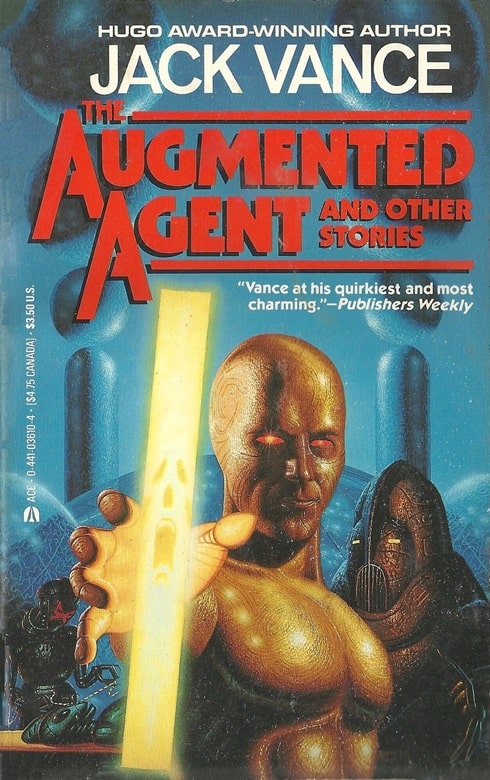 |
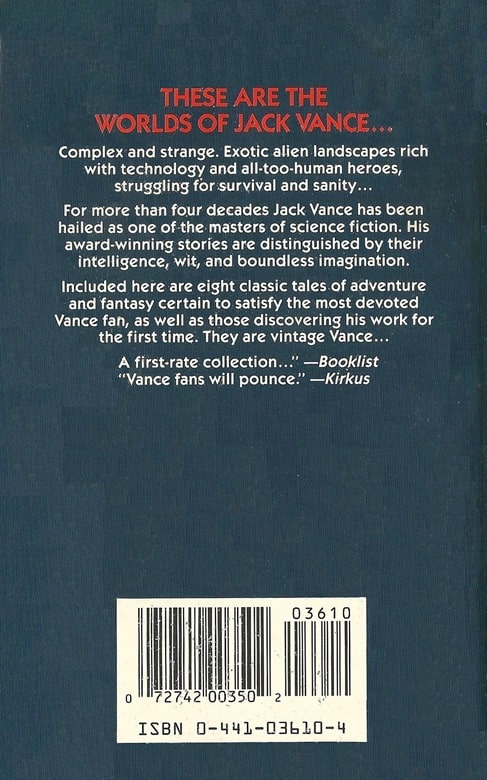 |
The Augmented Agent (Ace Books, September 1988). Cover by Terry Oakes
I need to read more Jack Vance.
It’s not hard to do. Virtually all of his short fiction has been collected over the years, in places like the five-volume The Early Jack Vance, edited by Terry Dowling and Jonathan Strahan, and the massive The Jack Vance Treasury.
Of course, those are small press collections, and if you’re looking for a more affordable way to dip your toe into the fast-moving waters of Jack Vance, then I recommend one of his fine paperback collections, like The Worlds of Jack Vance, The Best of Jack Vance, or today’s Vintage Treasure, The Augmented Agent, which collects eight Vance rarities, chiefly pulp adventures tales from very early in his career.
[Click images for Augmented versions.]
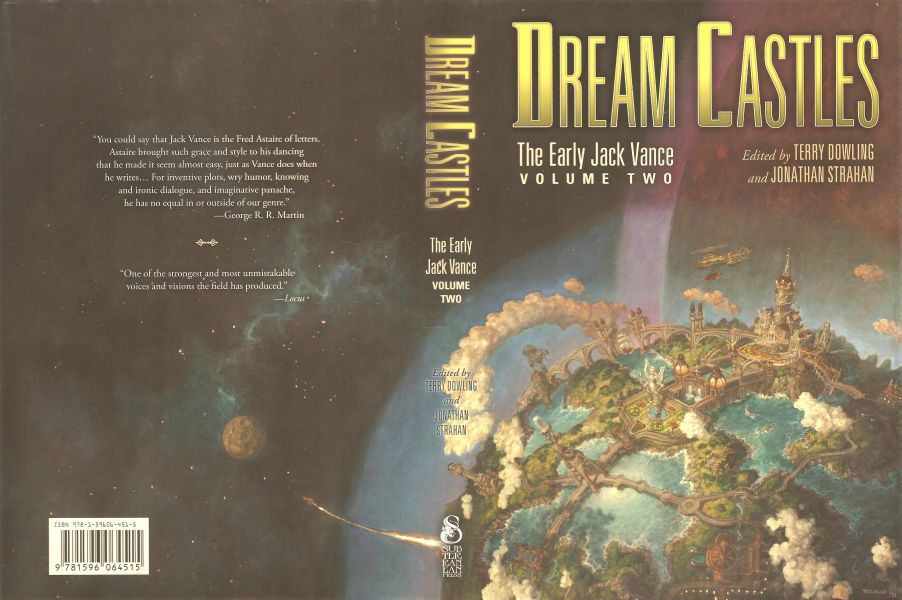 |
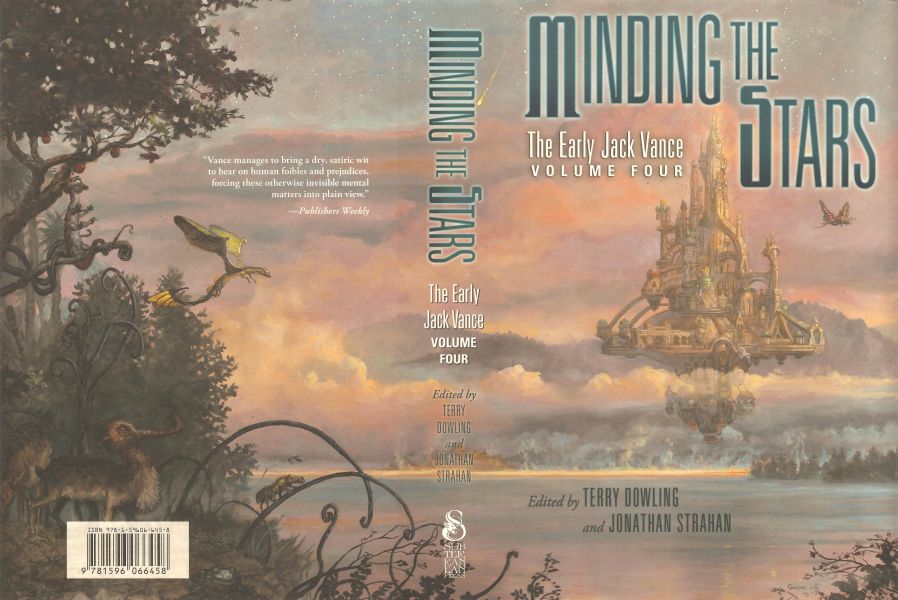 |
Two volumes of The Early Jack Vance: Dream Castles and Minding the Stars, edited by Terry
Dowling and Jonathan Strahan (Subterranean Press, 2012 and 2014). Covers by Tom Kidd
The Augmented Agent gathers stories from half a dozen pulp and digest magazines published between 1951-1967, specifically Amazing Stories, Marvel Science, Thrilling Wonder Stories, Startling Stories, Cosmos Science Fiction and Fantasy Magazine, and If. Most come from the very early fifties, just a few years after he made his debut with “The World-Thinker,” in the Summer 1945 issue of Thrilling Wonder Stories at the age of 29.
They have titles like “The Plagian Siphon” (retitled “The Planet Machine” for inclusion here), from the October 1951 issue of Thrilling Wonder; “Golden Girl,” from Marvel Science Stories, May 1951; the novella “The Man from Zodiac” (Amazing Stories, August 1967), and the title story, originally titled “I-C-a-BeM” for its appearance in the Cold-War era Amazing Stories (October 1961 issue).
I’ve collected some of the original art for the first appearance of three of the stories below. Because if we’re going to appreciate pulp Vance, we should have the full experience.
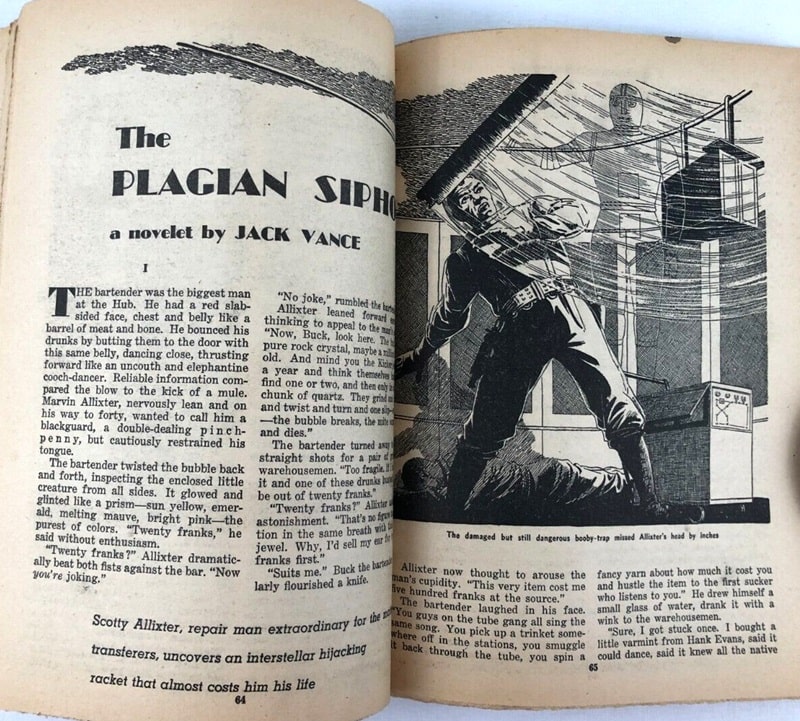 |
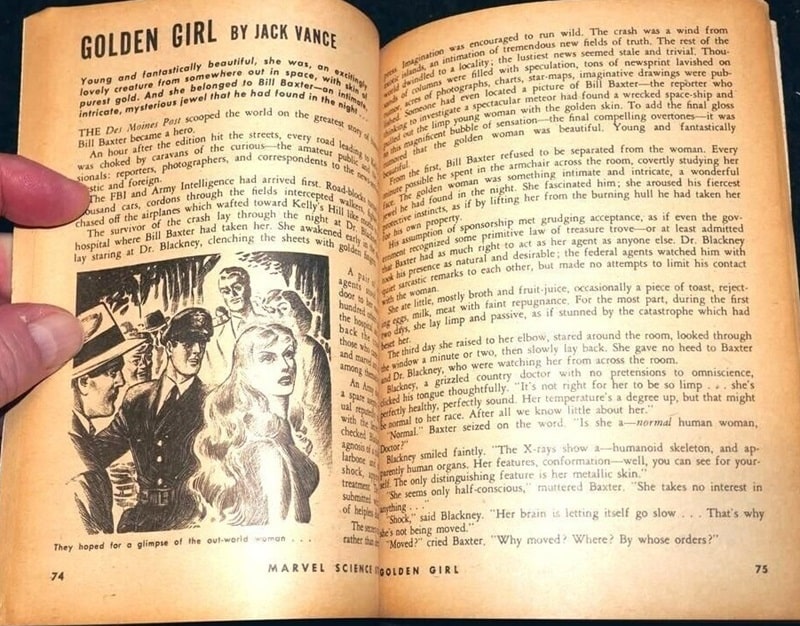 |
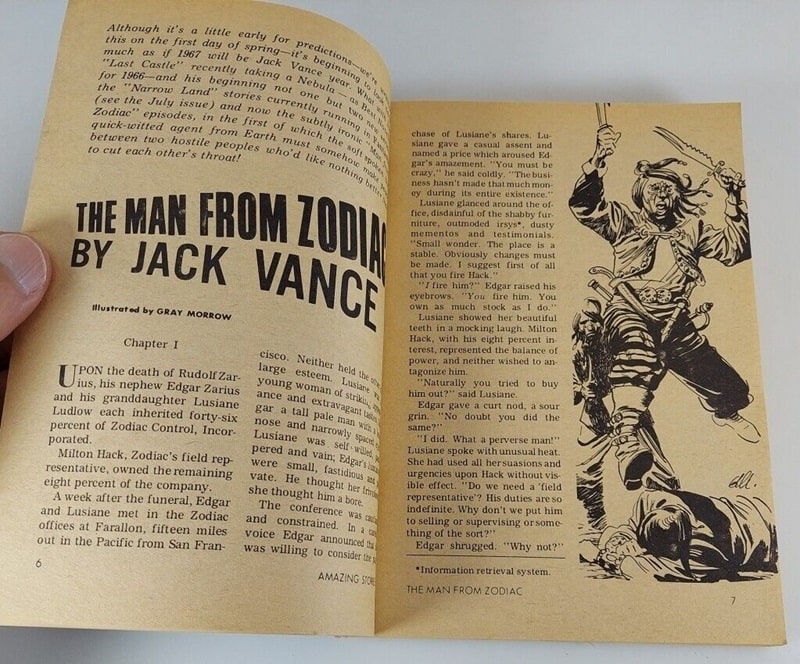 |
Interior art for the original stories: “The Plagian Siphon,” art uncredited (Thrilling Wonder
Stories, October 1951), “Golden Girl” art by Carol Burgos (Marvel Science Stories, May 1951),
and “The Man from Zodiac,” art by Gray Morrow (Amazing Stories, August 1967)
What do modern readers make of these 70-year old stories from a pulp master still learning his craft?
Here’s the 1986 notice from Kirkus Reviews, for the original Underwood-Miller hardcover edition.
Eight previously uncollected yarns, somewhat variable in quality, the oldest dating from 1951, featuring a wide range of themes and treatments. The best of the bunch show the typical Vance wit, casual intricacy, and sure narrative grasp. Interstellar effectuator Milton Hack, obliged to enforce a contract foisted on him by an idiotic superior, tangles with rival barbarian tribes intent on mayhem and loot. An Earth technician with an eye for profit plunges into an adventure where an interstellar transporter machine, gone haywire, slaughters its alien builders — and anyone else unfortunate enough to blunder along. The title piece involves a cyborg-enhanced CIA agent who, to preserve an African democracy against stiff Russian and Chinese opposition, kills and replaces a key politician — eventually to find that he’s not just acting but being his role. A well-handled long story about a slave rebellion on a distant world foreshadows such novels as Slaves of the Klau and the Demon Princes series… These are rarities, long out of print, and Vance fans will pounce.
Read the whole thing here.
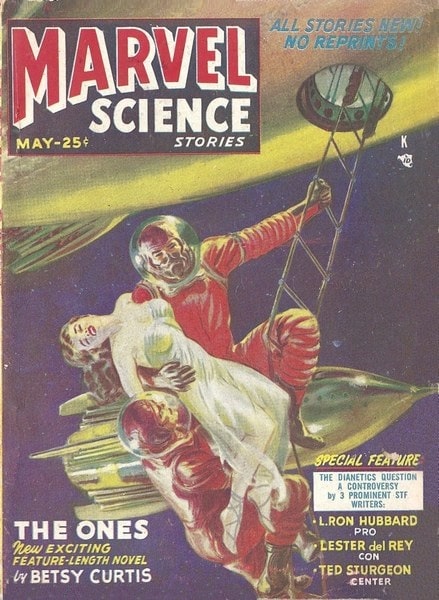 |
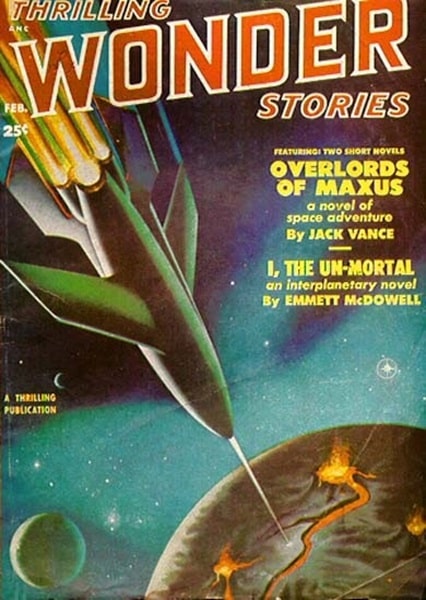 |
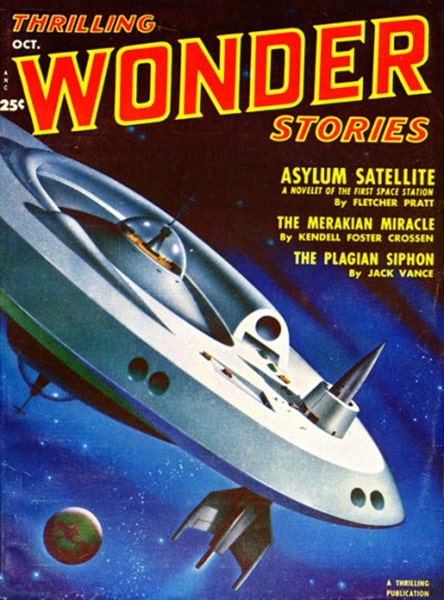 |
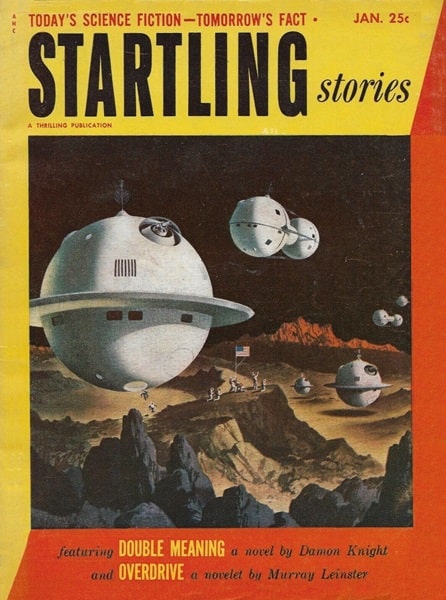 |
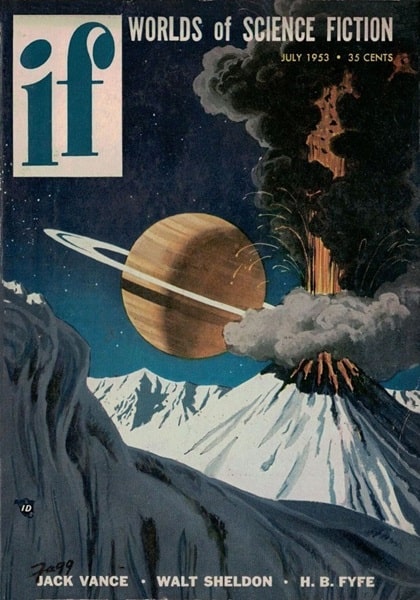 |
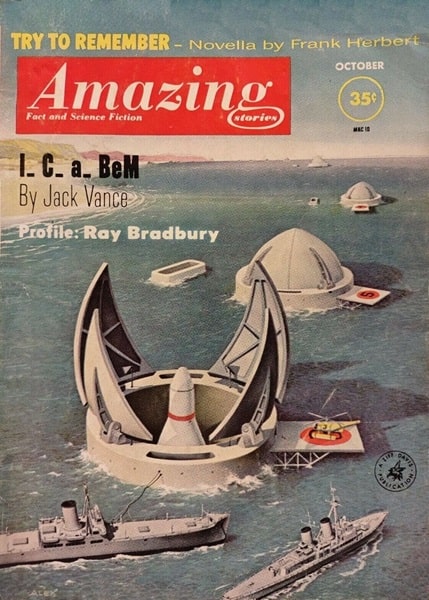 |
Magazine sources for the tales in The Augmented Agent: Marvel Science Stories,
May 1951, Thrilling Wonder Stories, February 1951, Thrilling Wonder Stories,
October 1951, Startling Stories, January 1953, If, July 1953,
Amazing Stories, October 1961. Cover art by Norman Saunders, uncredited,
Alex Schomburg, Alex Schomburg, Ken Fagg, Alex Schomburg
Since this is Jack Vance we’re talking about, people are still discussing (and enjoying) these stories. Here’s a excerpt from Mark Monday’s on-point wrap-up at Goodreads.
“Shape-Up” — 4 stars
A trap is sprung, concealed weapons are revealed, mysteries are solved… a master class [in] saying a lot with a little. A whole society and way of living are outlined briskly, tantalizingly.
“The Man from Zodiac” — 4 stars
Zodiac Control Inc. creates governments. Milton Hack is their nondescript field representative. Poor Milton has to deal with creating a functioning society out of two gross barbarian clans. Achieving this will require skulduggery, bamboozlement, mining operations, and putting greed and opportunism to work in the service of the greater good. This is Vance at his most sardonic and dispassionate. Fun stuff!
“Crusade to Maxus” — 4 stars
‘Tis revolution time! Technocrat slavers must die! This was a rousing adventure delivered coolly in the classic ironic Vancean style. Although there was less irony and more satisfying albeit brutal schadenfreude in the exciting finale of technocratic overlords vs. telepathic revolutionaries. One side holds rather an advantage… ¯\_(ツ)_/¯
“The Augmented Agent” — 5 stars
A Cold War espionage tale set in the imaginary African country of Lakhadi, caught between the Soviet Union and China, and trying to forge its own destiny. It is rife with cyborg agents: spies, assassins, and doubles; its hero an African-American spy in the highly augmented, weaponized guise of a tribal chieftain. Vance quickly removed any fears I may have had of reading a potentially colonialist take on Africa. His sympathies are squarely with a Free Lakhadi — one that could unite and lead the African nations — while still retaining his typically ironic perspective. The finale of multiple doubles trying to take each other out was wild.
“Peculiar sort of assassination,” he reflected. “Everyone gets killed but the victim.”
Read the whole review here.
Thrilling Wonder‘s story blurb for “Overlords of Maxus”
MPorcius reviewed the entire volume in his usual entertaining fashion at his MPorcius Fiction Log. Here’s the highlights.
“The Planet Machine” (1951/1986)
Remember how in Heinlein’s 1955 Tunnel in the Sky, Biggle’s 1963 All the Colors of Darkness, and J. T. McIntosh’s 1962 “One Into Two” there is a network of teleporters connecting different parts of the world and/or the galaxy? Here in “The Planet Machine” there is a similar system connecting many different Earth locations as well as different planets, facilitating trade and travel. Marvin “Scotty” Allixter is a technician whose job is to maintain and repair these teleporters. One day a slight irregularity is discovered with transmission to and from Rhetus — maybe the Rhetus machine just needs some fine tuning, but maybe some criminals have acquired their own teleporter machine and are rerouting transmissions of goods to themselves, stealing them. So Allixter puts on an armored suit and straps on a disrupter pistol and steps into the “tube,” bound for Rhetus to investigate.
He materializes not on Rhetus but some world unknown to man; he has walked out of an alien teleporter reception machine, but he sees no accompanying transmission machine. How can he get back to Earth? Using a computer translator, Allixter haltingly communicates with some natives of this world. These little weirdos lead him through a landscape of ruins to a machine — it turns out that this machine runs the entire planet in the interest not of the natives but of some aliens, the Plags, mining and refining resources and teleporting them to the Plag home world. The machine is supposed to run itself, and no Plags live on this planet. The machine’s security apparatus is currently malfunctioning, blowing up the mining and refining installations at random, and killing all the Plags sent to repair it. With the aid of the natives and his translation device, Allixter figures out how to avoid getting killed by this security system himself, how to repair the machine, and how to get back to Earth. He also figures out that his arrival here was no accident — he was deliberately sent as a kind of cat’s paw by a clandestine Plag agent on Earth. Allixter returns to Earth and neutralizes the Plag agent. Then, in the kind of denouement you find in detective stories, he explains to everybody (including readers like me who couldn’t figure it out ourselves) how he figured that stuff out…
“Shape-Up” (1953)
Gilbert Jarvis reads the Pegasus Square Farm and Mining Bulletin as he sits in a cafe, drinking hot anise he has purchased with the last of his coins (or coppers.) In response to a classified ad, he goes to an inn for a rigorous job interview, which includes a sort of group interview component. I still recall with dread some group job interviews of my experience, but this group interview that Jarvis finds himself involved in is more dreadful still. The job applicants are all rough tough adventurer types, and have been called together under false pretenses — according to the man managing the interview process, the gathered men are all suspects in a murder, and have been brought together so that the killer can be identified and then summarily executed!
This is a decent thriller story about violent, dangerous men in a sort of lawless environment. In true classic SF fashion the mystery is solved, and Jarvis’s life is saved, because Jarvis is a quick thinker who knows about science (in this case gravity.)
“The Man from Zodiac” (1967)
Martin Hack is the field representative of Zodiac Control, Inc., and owns an eight percent share of the company. Zodiac Control is an interstellar contractor that offers services to polities large and small — Zodiac will maintain order, enforce the law, extinguish fires, educate the young, manage the economy, and fight foreign enemies of those entities that sign a contract with them — Zodiac basically sets up and operates governments. The recent inheritors of 92% of Zodiac Control sign a seven-year contract with the state of Phronus on the planet Ethelrinda Cordas, and give Hack the job of managing this project.
Upon his arrival in Phronus, Hack learns that its people are semi-literate barbarians in a constant state of war (waged primarily at close range with swords and other such low-tech weapons) against their neighbors, the equally belligerent and primitive people of Sabo — the Phrones had hopes that Zodiac would supply them with high tech weapons with which to wipe out the Sabol. A pack of raiders and pirates, the Phrones would also like to pillage a sort of artists’ colony/intellectuals’ retreat known as Parnassus that sits nearby and is managed by one Cyril Dibden… The plot follows Hack’s efforts to bring peace and order to the Phronus-Parnassus-Sabo region; through trickery he not only drags Phronus and Sabo into the modern civilized era, but uncovers a conspiracy on the part of Cyril Dibden… “The Man from Zodiac” is a sort of light entertainment; it is smooth and pleasant, and made me laugh several times.
The Augmented Agent was originally published in hardcover by Underwood Miller as a limited edition hardcover, with an introduction by Steven Owen Godersky which does not appear in the Ace paperback. See the cover and inside flaps below (click for bigger versions).
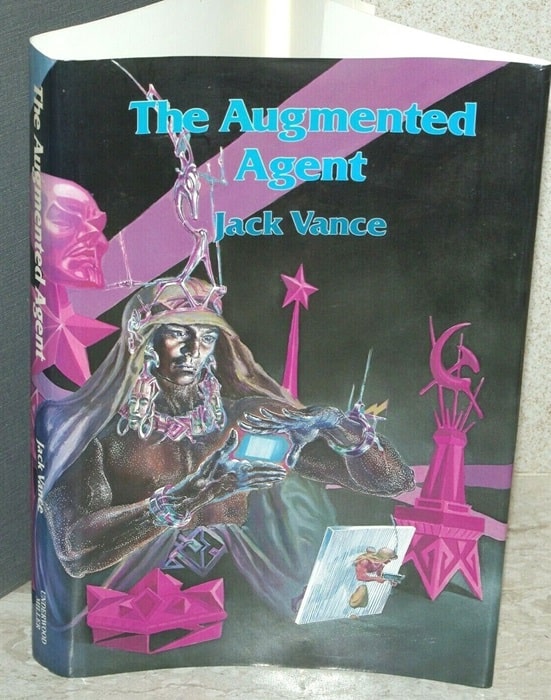 |
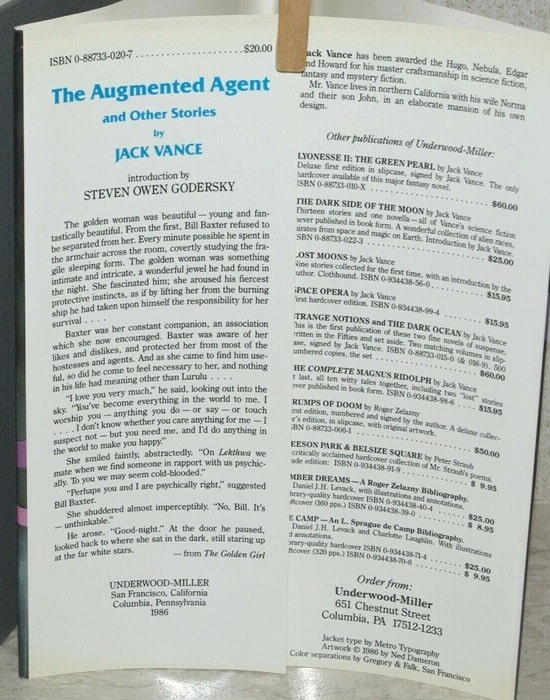 |
The Augmented Agent (Underwood-Miller, May 1986). Cover by Ned Dameron
The Augmented Agent contains two novellas, “The Man from Zodiac” and “Crusade to Maxus” (originally published as “Overlords of Maxus”). Here’s the complete TOC.
“Shape-Up” (Cosmos Science Fiction and Fantasy Magazine, November 1953)
“The Man from Zodiac” (Amazing Stories, August 1967)
“Golden Girl” (Marvel Science Stories, May 1951)
“The Planet Machine” (Thrilling Wonder Stories, October 1951)
“Crusade to Maxus” (Thrilling Wonder Stories, February 1951)
“Three-Legged Joe” (Startling Stories, January 1953)
“Sjambak” (If, July 1953)
“The Augmented Agent” (Amazing Stories, October 1961)
The book was reprinted in trade paperback in the UK by New English Library in 1989. It has been out of print for the last 36 years, and there it no digital edition. Not one I’ve been able to find, anyway.
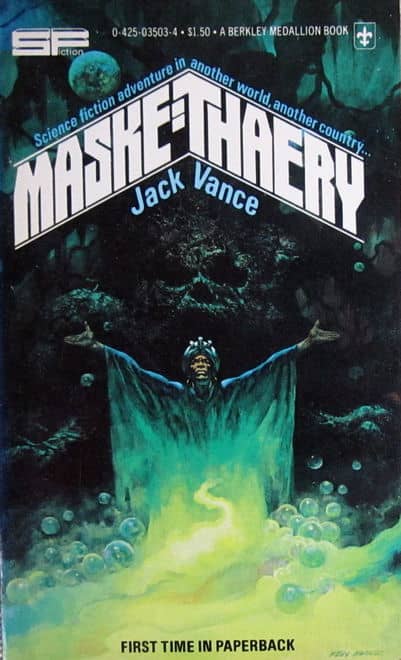 |
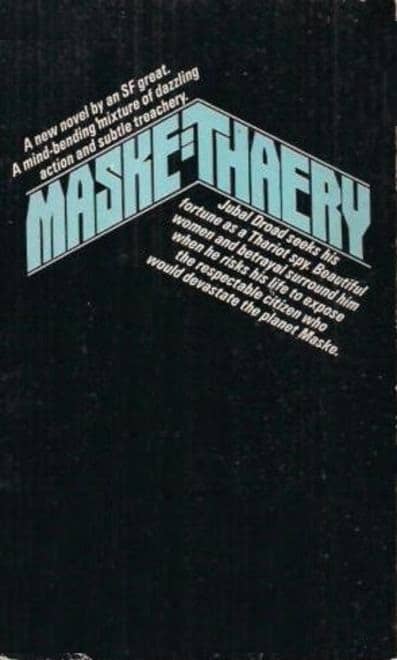 |
Maske: Thaery (Berkley Medallion, September 1977). Cover by Ken Barr
The Augmented Agent was published in hardcover by Underwood-Miller in May 1986, and reprinted as an Ace paperback in September 1988 (minus the introduction). It is 295 pages in paperback, priced at $3.50. The cover is by Terry Oakes.
Our previous coverage of Jack Vance includes:
A Tale of the Last Free Humans: Fletcher Vredenburgh on Jack Vance’s “The Dragon Masters” (2023)
Explore Jack Vance’s Rich and Dangerous Universe in The Gaean Reach from Pelgrane Press (2021)
Today is Jack Vance’s 104th Birthday by John-Henri Holmberg (2020)
Hector Dejean on Why Jack Vance was Science Fiction’s Tightest Worldbuilder (2019)
Birthday Reviews: Jack Vance’s “Liane The Wayfarer” by Steven H Silver (2018)
Jack Vance, August 28, 1916 — May 26, 2013 (2013)
Maske: Thaery
The Worlds of Jack Vance
Lyonesse: Suldrun’s Garden by Fletcher Vredenburgh
Green Magic: The Fantasy Realms of Jack Vance
The Durdane Trilogy
The Omnibus Volumes of Jack Vance, Part I: Planet of Adventure
The Omnibus Volumes of Jack Vance, Part II: Tales of the Dying Earth
The Omnibus Volumes of Jack Vance, Part III: The Demon Princes
Madouc
Dream Castles: The Early Jack Vance, Volume Two
Travel the Magic Highways with The Early Jack Vance, Volume Three, edited by Terry Dowling and Jonathan Strahan
It’s Good to be Minding the Stars with The Early Jack Vance, Volume Four, edited by Terry Dowling and Jonathan Strahan
The Early Novels of Jack Vance: Grand Crusades: The Early Jack Vance, Volume Five, edited by Terry Dowling and Jonathan Strahan
Big Planet
Jack Vance and Appendix N: Advanced Readings in D&D
See all of our recent Vintage Treasures here.
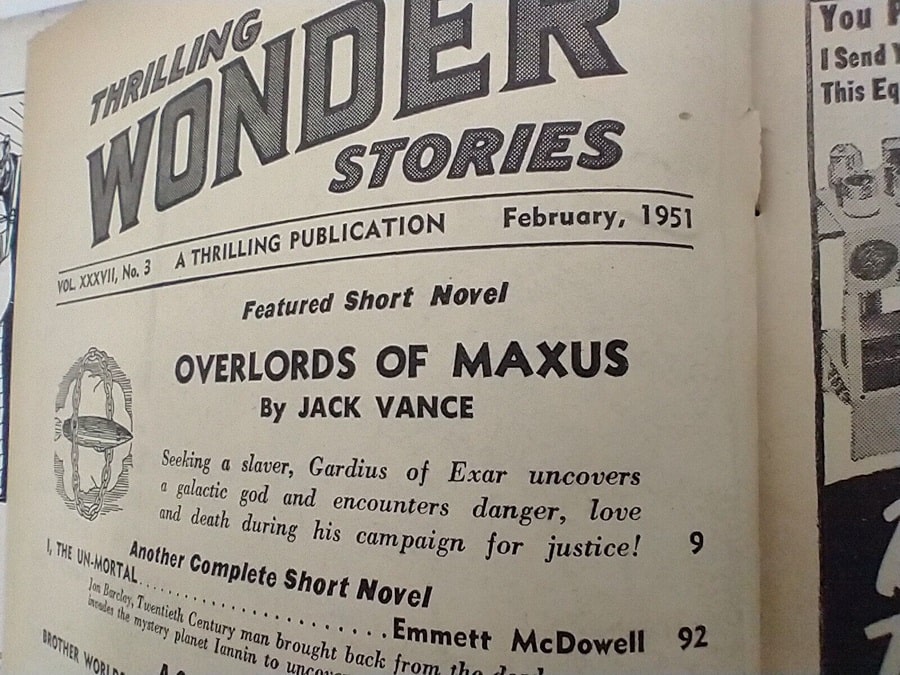
Re: “I need to read more Jack Vance.”
Everyone needs to read more Jack Vance!
He’s one of my favorite authors–I’ve been filling in the gaps of my collection of his works with the Splatterlight Press editions available through Amazon (I have about half the collection of books now). I discovered him during my golden age of SF in the late ’60s and early ’70s with his Durdane novels serialized in F&SF as well as the Alastor books in Amazing. Fantasy, science fiction, mysteries, regular fiction–he’s done it all.
I’ve even drove on a trip through Canada a few years back listening to his Tschai, Planet of Adventure Series, unabridged, on CDs–hard to concentrate on the scenery around you when listening to Vance’s prose come to life.
Great man, great works!
Lou,
I had no idea the Durdane novels were serialized in F&SF. I checked ISFDB and you’re absolutely right — the first one, The Faceless Man, was published in two parts starting in the February 1971 issue. Now I’ll have to dig my copies out of storage!
I didn’t know the Planet of Adventure novels were available on audio either. Stick around — you’re a font of useful information!
Most of the hardcover books from Subterranean Press can be ebooks for about $5.99.
Steve,
That’s great info. These are terrific books. Sub Press did a fabulous job, and I’m glad the ebooks are still available.
This is indeed a collection of obscure Vance! I have read only a couple of these. I remember enjoying “Overlords of Maxus” in that issue of Thrilling Wonder. I’m sure these are mostly minor Vance, but even minor Vance usually entertains.
Rich,
I was pretty sure you’d read at least a few of them. 🙂
I’m sure I have most of the original magazines, but I don’t dig my copies out of storage in the basement very often. Unlike Doug Ellis, my pulp library is hit or miss for condition — and my Thrilling Wonders in particular are well read!
I also need to read more Jack Vance! Which is to say that I’ve read _most_ Jack Vance over the years, but there are still gaps to fill in, especially the mysteries and some of the early short fiction.
Joe,
You’re not the only one. I need to take a Jack Vance reading holiday.
What was most striking – to me, anyway – about Vance (especially coming from a sf writer of his generation) was his absolutely unique voice. When he’s got a full head of steam, it’s impossible to mistake him for anyone else, and that’s something that I value highly.
Thomas,
Speaking of things I value highly… what would it take to entice you to review some of your favorite Vance for us? You’re one of the few folks I think who could do him justice.
I’ll just put it in the hopper with the thirty-four (I’m not kidding – I just counted) other pieces I have in various stages of incompletion…
I believe it. With that many irons in the fire, it’s a miracle you finish anything!